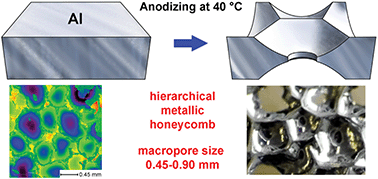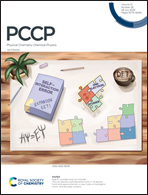Multilevel self-organization on anodized aluminium: discovering hierarchical honeycomb structures from nanometre to sub-millimetre scale†
Abstract
Herein, the one-step spontaneous formation of multiscale hierarchical honeycomb-like textures on anodized aluminium is reported for the first time. A self-organized array of unprecedentedly large sub-millimetre hemispherical pores was observed on the upper hierarchy level, while superimposed well-ordered hexagonal cells on the lower hierarchy level maintained their classically known nanoscale self-ordering periodicity (50–60 nm). The larger macroscopic cells (0.45–0.90 mm) show great morphological similarity to the conventional nanosized porous anodic structures, but arise on a purely metallic surface without any analytically detectable amount of deposited alumina. The observed cell size expansion (approximately by a factor of 104) during Al anodizing is colossal in comparison with the size variation ranges reported in the literature so far. It reveals a dramatic nonlinearity effect in a dynamic self-organizing system upon a moderate change of experimental parameters (specifically, this work focuses on the effect of anodizing temperature). Such multilevel self-organization in a single aluminium anodizing process sheds new light on the origin of self-ordered anodic structures and allows rethinking the whole range of opinions regarding their formation mechanism that have been proposed to date.

- This article is part of the themed collection: 2020 PCCP HOT Articles


 Please wait while we load your content...
Please wait while we load your content...